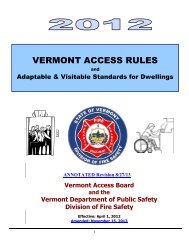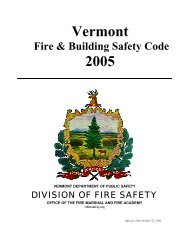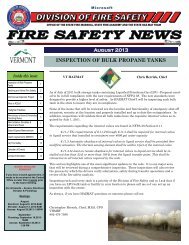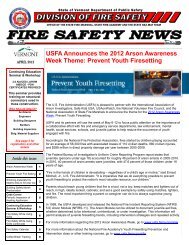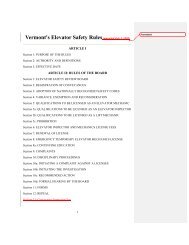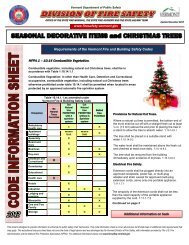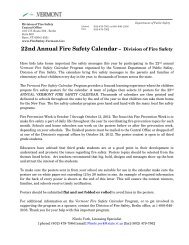October - Vermont Division of Fire Safety - Vermont.gov
October - Vermont Division of Fire Safety - Vermont.gov
October - Vermont Division of Fire Safety - Vermont.gov
Create successful ePaper yourself
Turn your PDF publications into a flip-book with our unique Google optimized e-Paper software.
PAGE 2 OCTOBER 2012<br />
<strong>Vermont</strong> Department <strong>of</strong> Public <strong>Safety</strong><br />
<strong>Division</strong> <strong>of</strong> <strong>Fire</strong> <strong>Safety</strong><br />
Micheal D. Greenia <strong>Fire</strong> <strong>Safety</strong> Education and Information Coordinator 1311 US Route 302 Barre VT 802.479.7587 mgreenia@dps.state.vt.us<br />
About <strong>Fire</strong> Prevention Week<br />
The National <strong>Fire</strong> Protection Association’s (NFPA) annual awareness campaign, <strong>Fire</strong> Prevention Week, is slated for <strong>October</strong><br />
7-13. The non-pr<strong>of</strong>it fire safety organization is reminding the public to, ‘Have 2 Ways Out’, the theme for this year’s effort which<br />
focuses on the importance <strong>of</strong> having multiple escape routes in the event <strong>of</strong> a fire.<br />
<strong>Fire</strong> Prevention Week was established to commemorate the Great Chicago <strong>Fire</strong>, the tragic<br />
1871 conflagration that killed more than 250 people, left 100,000 homeless, destroyed more<br />
than 17,400 structures and burned more than 2,000 acres. The fire began on <strong>October</strong> 8, but<br />
continued into and did most <strong>of</strong> its damage on <strong>October</strong> 9, 1871.<br />
According to popular legend, the fire broke out after a cow - belonging to Mrs. Catherine<br />
O'Leary - kicked over a lamp, setting first the barn, then the whole city on fire. Chances are<br />
you've heard some version <strong>of</strong> this story yourself; people have been blaming the Great<br />
Chicago <strong>Fire</strong> on the cow and Mrs. O'Leary, for more than 130 years. But recent research by<br />
Chicago historian Robert Cromie has helped to debunk this version <strong>of</strong> events.<br />
While the Great Chicago <strong>Fire</strong> was the best-known blaze to start during this fiery two-day<br />
stretch, it wasn't the biggest. That distinction goes to the Peshtigo <strong>Fire</strong>, the most devastating<br />
forest fire in American history. The fire, which also occurred on <strong>October</strong> 8th, 1871, and roared<br />
through Northeast Wisconsin, burning down 16 towns, killing 1,152 people, and scorching 1.2<br />
million acres before it ended.<br />
Plan Ahead<br />
Since 1922, <strong>Fire</strong> Prevention<br />
Week has been observed on<br />
the Sunday through Saturday<br />
period in which <strong>October</strong> 9 falls.<br />
Here are dates for future FPW<br />
campaigns:<br />
2013: <strong>October</strong> 6-12<br />
2014: <strong>October</strong> 5-11<br />
2015: <strong>October</strong> 4-10<br />
Historical accounts <strong>of</strong> the fire say that the blaze began when several railroad workers clearing land for tracks unintentionally<br />
started a brush fire. Before long, the fast-moving flames were whipping through the area 'like a tornado,' some survivors said. It<br />
was the small town <strong>of</strong> Peshtigo, Wisconsin that suffered the worst damage. Within an hour, the entire town had been<br />
destroyed.<br />
Those who survived the Chicago and Peshtigo fires never forgot what they'd been through; both blazes produced countless<br />
tales <strong>of</strong> bravery and heroism. But the fires also changed the way that firefighters and public <strong>of</strong>ficials thought about fire safety.<br />
On the 40th anniversary <strong>of</strong> the Great Chicago <strong>Fire</strong>, the <strong>Fire</strong> Marshals Association <strong>of</strong> North America (today known as the<br />
International <strong>Fire</strong> Marshals Association), decided that the anniversary <strong>of</strong> the Great Chicago <strong>Fire</strong> should henceforth be observed<br />
not with festivities, but in a way that would keep the public informed about the importance <strong>of</strong> fire prevention. The<br />
commemoration grew incrementally <strong>of</strong>ficial over the years.<br />
In 1920, President Woodrow Wilson issued the first National <strong>Fire</strong> Prevention Day proclamation, and since 1922, <strong>Fire</strong> Prevention<br />
Week has been observed on the Sunday through Saturday period in which <strong>October</strong> 9 falls.<br />
The NFPA has been the <strong>of</strong>ficial sponsor <strong>of</strong> <strong>Fire</strong> Prevention Week since 1922. According to the National Archives and Records<br />
Administration's Library Information Center, <strong>Fire</strong> Prevention Week is the longest running public health and safety observance<br />
on record. The President <strong>of</strong> the United States has signed a proclamation proclaiming a national observance during that week<br />
every year since 1925. Visit www.firepreventionweek.org for more safety information.<br />
Reproduced from NFPA's <strong>Fire</strong> Prevention Week website, www.firepreventionweek.org. ©2012 NFPA.




